Intercultural Management in Business - MAR015-2: Literature Review
VerifiedAdded on 2022/12/26
|8
|1727
|95
Report
AI Summary
This report provides an in-depth analysis of intercultural management in a business context. It begins with an introduction to the concept, emphasizing the importance of understanding cultural nuances. The report then delves into Hofstede's cultural dimensions, specifically masculinity versus femininity, evaluating its display in work settings and its implications. Furthermore, it demonstrates an understanding of cultural dimensions, regularity, and variability, producing frameworks for investigating the impact of culture on international business. Finally, the report evaluates different strategies used in international business to manage cross-cultural situations in the workplace, such as embracing diversity and promoting open communication, before concluding with a summary of key findings and a list of references.

INTERCULTURAL
MANAGEMENT IN BUSINESS
MANAGEMENT IN BUSINESS
Paraphrase This Document
Need a fresh take? Get an instant paraphrase of this document with our AI Paraphraser
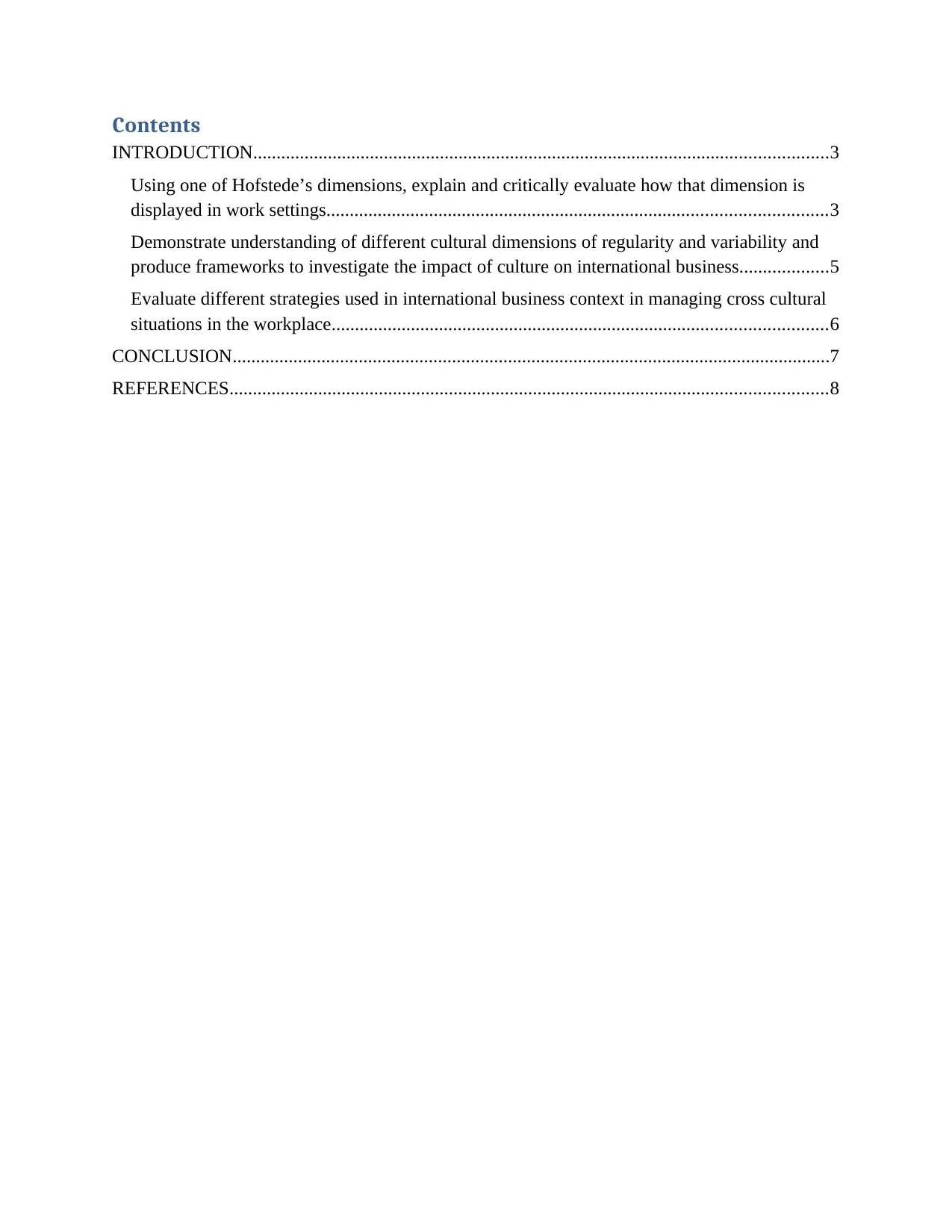
Contents
INTRODUCTION...........................................................................................................................3
Using one of Hofstede’s dimensions, explain and critically evaluate how that dimension is
displayed in work settings...........................................................................................................3
Demonstrate understanding of different cultural dimensions of regularity and variability and
produce frameworks to investigate the impact of culture on international business...................5
Evaluate different strategies used in international business context in managing cross cultural
situations in the workplace..........................................................................................................6
CONCLUSION................................................................................................................................7
REFERENCES................................................................................................................................8
INTRODUCTION...........................................................................................................................3
Using one of Hofstede’s dimensions, explain and critically evaluate how that dimension is
displayed in work settings...........................................................................................................3
Demonstrate understanding of different cultural dimensions of regularity and variability and
produce frameworks to investigate the impact of culture on international business...................5
Evaluate different strategies used in international business context in managing cross cultural
situations in the workplace..........................................................................................................6
CONCLUSION................................................................................................................................7
REFERENCES................................................................................................................................8
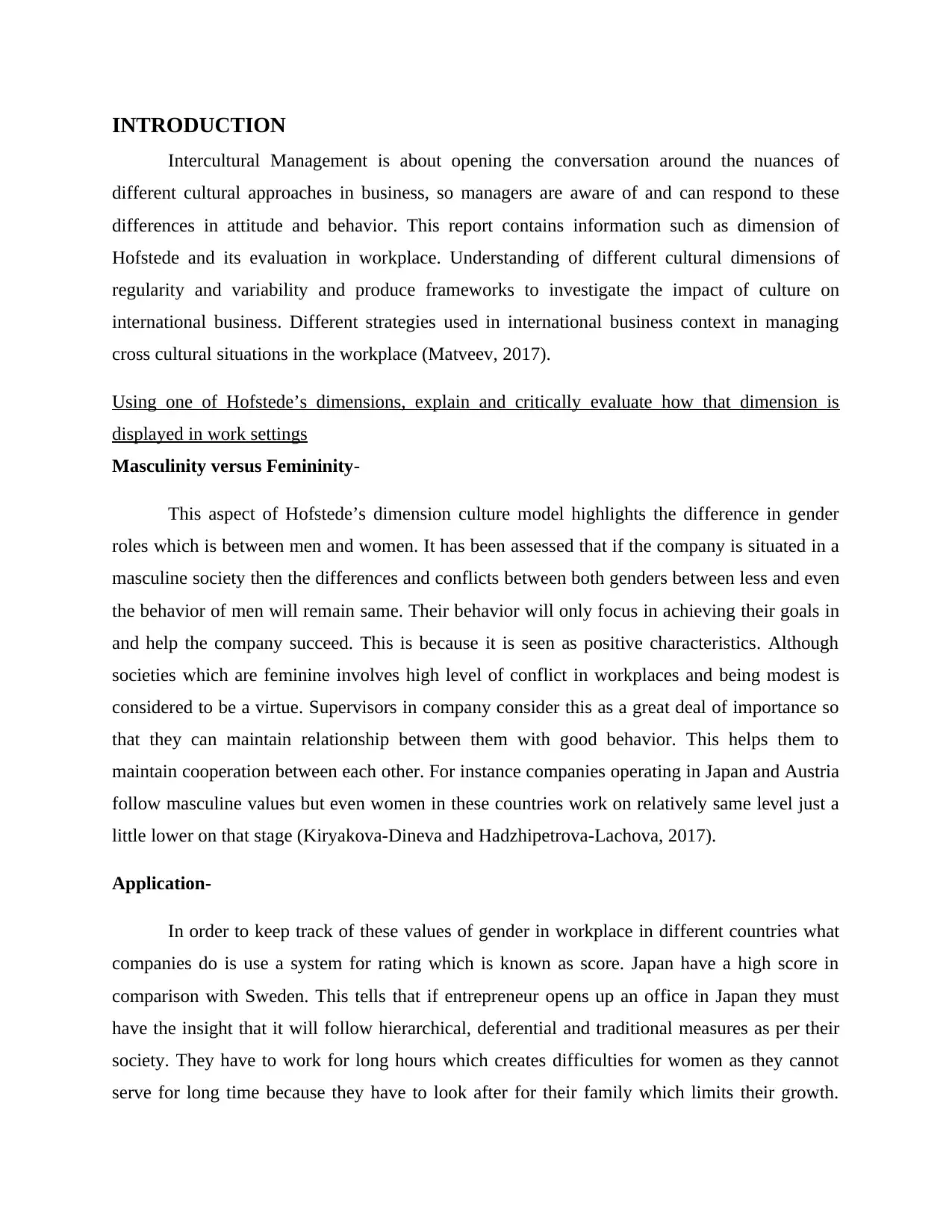
INTRODUCTION
Intercultural Management is about opening the conversation around the nuances of
different cultural approaches in business, so managers are aware of and can respond to these
differences in attitude and behavior. This report contains information such as dimension of
Hofstede and its evaluation in workplace. Understanding of different cultural dimensions of
regularity and variability and produce frameworks to investigate the impact of culture on
international business. Different strategies used in international business context in managing
cross cultural situations in the workplace (Matveev, 2017).
Using one of Hofstede’s dimensions, explain and critically evaluate how that dimension is
displayed in work settings
Masculinity versus Femininity-
This aspect of Hofstede’s dimension culture model highlights the difference in gender
roles which is between men and women. It has been assessed that if the company is situated in a
masculine society then the differences and conflicts between both genders between less and even
the behavior of men will remain same. Their behavior will only focus in achieving their goals in
and help the company succeed. This is because it is seen as positive characteristics. Although
societies which are feminine involves high level of conflict in workplaces and being modest is
considered to be a virtue. Supervisors in company consider this as a great deal of importance so
that they can maintain relationship between them with good behavior. This helps them to
maintain cooperation between each other. For instance companies operating in Japan and Austria
follow masculine values but even women in these countries work on relatively same level just a
little lower on that stage (Kiryakova-Dineva and Hadzhipetrova-Lachova, 2017).
Application-
In order to keep track of these values of gender in workplace in different countries what
companies do is use a system for rating which is known as score. Japan have a high score in
comparison with Sweden. This tells that if entrepreneur opens up an office in Japan they must
have the insight that it will follow hierarchical, deferential and traditional measures as per their
society. They have to work for long hours which creates difficulties for women as they cannot
serve for long time because they have to look after for their family which limits their growth.
Intercultural Management is about opening the conversation around the nuances of
different cultural approaches in business, so managers are aware of and can respond to these
differences in attitude and behavior. This report contains information such as dimension of
Hofstede and its evaluation in workplace. Understanding of different cultural dimensions of
regularity and variability and produce frameworks to investigate the impact of culture on
international business. Different strategies used in international business context in managing
cross cultural situations in the workplace (Matveev, 2017).
Using one of Hofstede’s dimensions, explain and critically evaluate how that dimension is
displayed in work settings
Masculinity versus Femininity-
This aspect of Hofstede’s dimension culture model highlights the difference in gender
roles which is between men and women. It has been assessed that if the company is situated in a
masculine society then the differences and conflicts between both genders between less and even
the behavior of men will remain same. Their behavior will only focus in achieving their goals in
and help the company succeed. This is because it is seen as positive characteristics. Although
societies which are feminine involves high level of conflict in workplaces and being modest is
considered to be a virtue. Supervisors in company consider this as a great deal of importance so
that they can maintain relationship between them with good behavior. This helps them to
maintain cooperation between each other. For instance companies operating in Japan and Austria
follow masculine values but even women in these countries work on relatively same level just a
little lower on that stage (Kiryakova-Dineva and Hadzhipetrova-Lachova, 2017).
Application-
In order to keep track of these values of gender in workplace in different countries what
companies do is use a system for rating which is known as score. Japan have a high score in
comparison with Sweden. This tells that if entrepreneur opens up an office in Japan they must
have the insight that it will follow hierarchical, deferential and traditional measures as per their
society. They have to work for long hours which creates difficulties for women as they cannot
serve for long time because they have to look after for their family which limits their growth.
⊘ This is a preview!⊘
Do you want full access?
Subscribe today to unlock all pages.

Trusted by 1+ million students worldwide
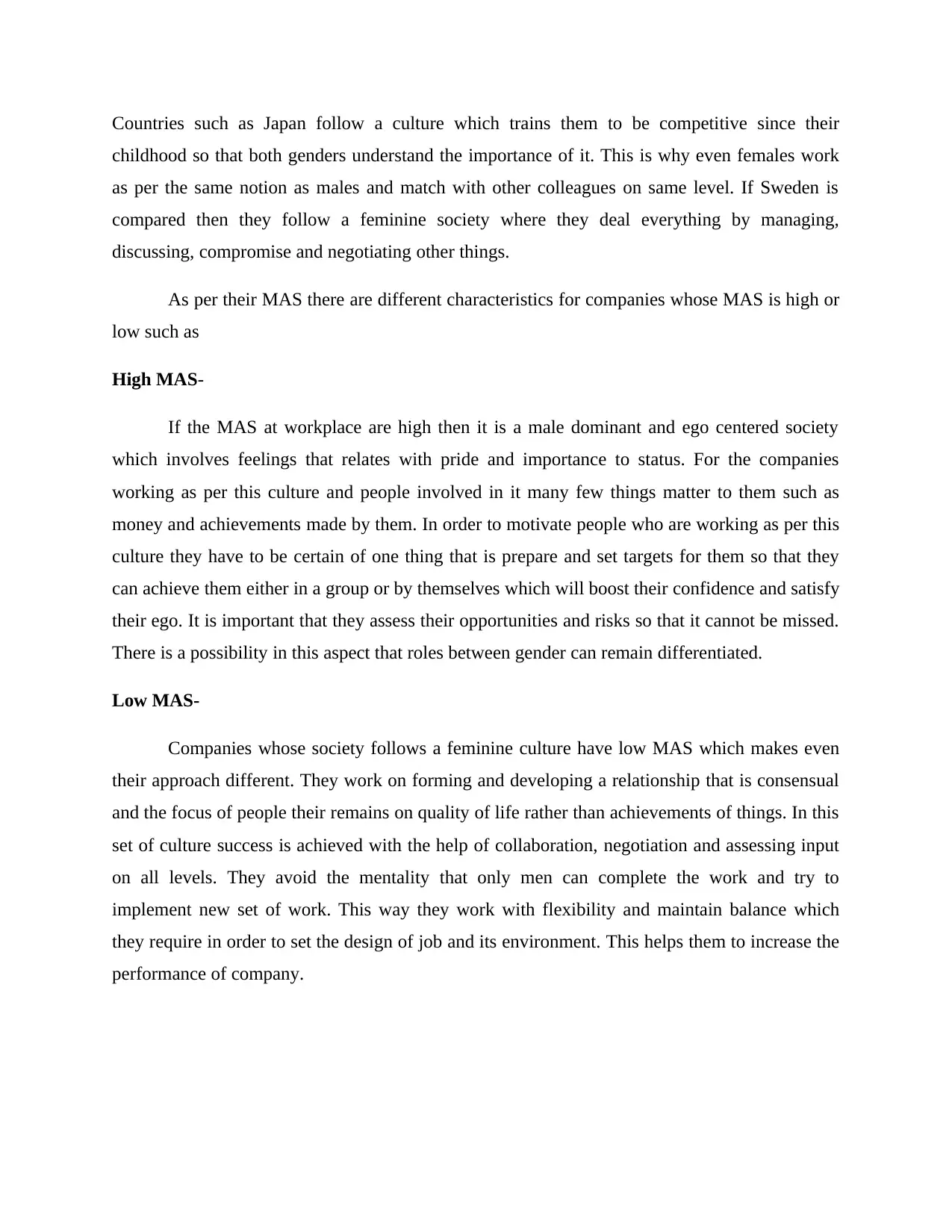
Countries such as Japan follow a culture which trains them to be competitive since their
childhood so that both genders understand the importance of it. This is why even females work
as per the same notion as males and match with other colleagues on same level. If Sweden is
compared then they follow a feminine society where they deal everything by managing,
discussing, compromise and negotiating other things.
As per their MAS there are different characteristics for companies whose MAS is high or
low such as
High MAS-
If the MAS at workplace are high then it is a male dominant and ego centered society
which involves feelings that relates with pride and importance to status. For the companies
working as per this culture and people involved in it many few things matter to them such as
money and achievements made by them. In order to motivate people who are working as per this
culture they have to be certain of one thing that is prepare and set targets for them so that they
can achieve them either in a group or by themselves which will boost their confidence and satisfy
their ego. It is important that they assess their opportunities and risks so that it cannot be missed.
There is a possibility in this aspect that roles between gender can remain differentiated.
Low MAS-
Companies whose society follows a feminine culture have low MAS which makes even
their approach different. They work on forming and developing a relationship that is consensual
and the focus of people their remains on quality of life rather than achievements of things. In this
set of culture success is achieved with the help of collaboration, negotiation and assessing input
on all levels. They avoid the mentality that only men can complete the work and try to
implement new set of work. This way they work with flexibility and maintain balance which
they require in order to set the design of job and its environment. This helps them to increase the
performance of company.
childhood so that both genders understand the importance of it. This is why even females work
as per the same notion as males and match with other colleagues on same level. If Sweden is
compared then they follow a feminine society where they deal everything by managing,
discussing, compromise and negotiating other things.
As per their MAS there are different characteristics for companies whose MAS is high or
low such as
High MAS-
If the MAS at workplace are high then it is a male dominant and ego centered society
which involves feelings that relates with pride and importance to status. For the companies
working as per this culture and people involved in it many few things matter to them such as
money and achievements made by them. In order to motivate people who are working as per this
culture they have to be certain of one thing that is prepare and set targets for them so that they
can achieve them either in a group or by themselves which will boost their confidence and satisfy
their ego. It is important that they assess their opportunities and risks so that it cannot be missed.
There is a possibility in this aspect that roles between gender can remain differentiated.
Low MAS-
Companies whose society follows a feminine culture have low MAS which makes even
their approach different. They work on forming and developing a relationship that is consensual
and the focus of people their remains on quality of life rather than achievements of things. In this
set of culture success is achieved with the help of collaboration, negotiation and assessing input
on all levels. They avoid the mentality that only men can complete the work and try to
implement new set of work. This way they work with flexibility and maintain balance which
they require in order to set the design of job and its environment. This helps them to increase the
performance of company.
Paraphrase This Document
Need a fresh take? Get an instant paraphrase of this document with our AI Paraphraser
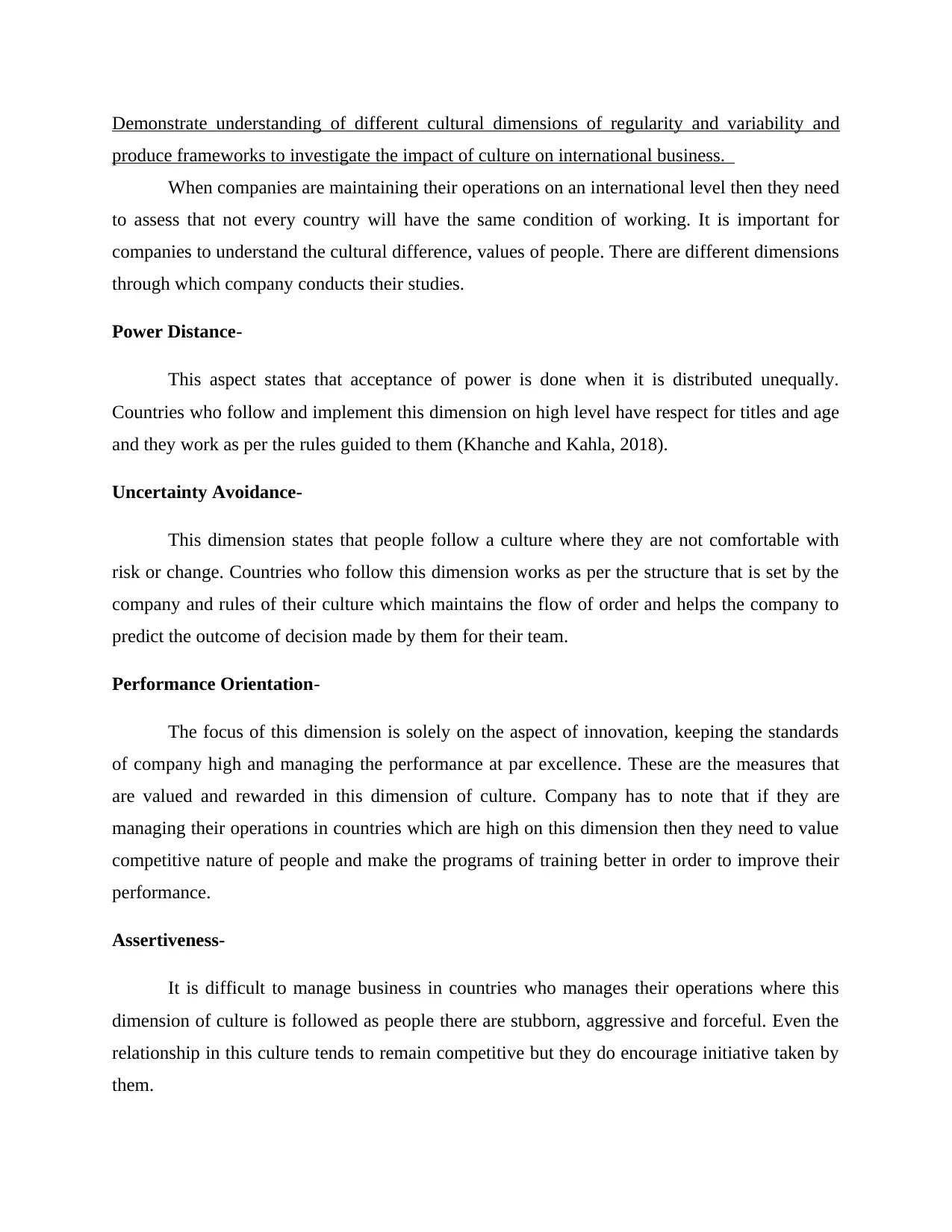
Demonstrate understanding of different cultural dimensions of regularity and variability and
produce frameworks to investigate the impact of culture on international business.
When companies are maintaining their operations on an international level then they need
to assess that not every country will have the same condition of working. It is important for
companies to understand the cultural difference, values of people. There are different dimensions
through which company conducts their studies.
Power Distance-
This aspect states that acceptance of power is done when it is distributed unequally.
Countries who follow and implement this dimension on high level have respect for titles and age
and they work as per the rules guided to them (Khanche and Kahla, 2018).
Uncertainty Avoidance-
This dimension states that people follow a culture where they are not comfortable with
risk or change. Countries who follow this dimension works as per the structure that is set by the
company and rules of their culture which maintains the flow of order and helps the company to
predict the outcome of decision made by them for their team.
Performance Orientation-
The focus of this dimension is solely on the aspect of innovation, keeping the standards
of company high and managing the performance at par excellence. These are the measures that
are valued and rewarded in this dimension of culture. Company has to note that if they are
managing their operations in countries which are high on this dimension then they need to value
competitive nature of people and make the programs of training better in order to improve their
performance.
Assertiveness-
It is difficult to manage business in countries who manages their operations where this
dimension of culture is followed as people there are stubborn, aggressive and forceful. Even the
relationship in this culture tends to remain competitive but they do encourage initiative taken by
them.
produce frameworks to investigate the impact of culture on international business.
When companies are maintaining their operations on an international level then they need
to assess that not every country will have the same condition of working. It is important for
companies to understand the cultural difference, values of people. There are different dimensions
through which company conducts their studies.
Power Distance-
This aspect states that acceptance of power is done when it is distributed unequally.
Countries who follow and implement this dimension on high level have respect for titles and age
and they work as per the rules guided to them (Khanche and Kahla, 2018).
Uncertainty Avoidance-
This dimension states that people follow a culture where they are not comfortable with
risk or change. Countries who follow this dimension works as per the structure that is set by the
company and rules of their culture which maintains the flow of order and helps the company to
predict the outcome of decision made by them for their team.
Performance Orientation-
The focus of this dimension is solely on the aspect of innovation, keeping the standards
of company high and managing the performance at par excellence. These are the measures that
are valued and rewarded in this dimension of culture. Company has to note that if they are
managing their operations in countries which are high on this dimension then they need to value
competitive nature of people and make the programs of training better in order to improve their
performance.
Assertiveness-
It is difficult to manage business in countries who manages their operations where this
dimension of culture is followed as people there are stubborn, aggressive and forceful. Even the
relationship in this culture tends to remain competitive but they do encourage initiative taken by
them.
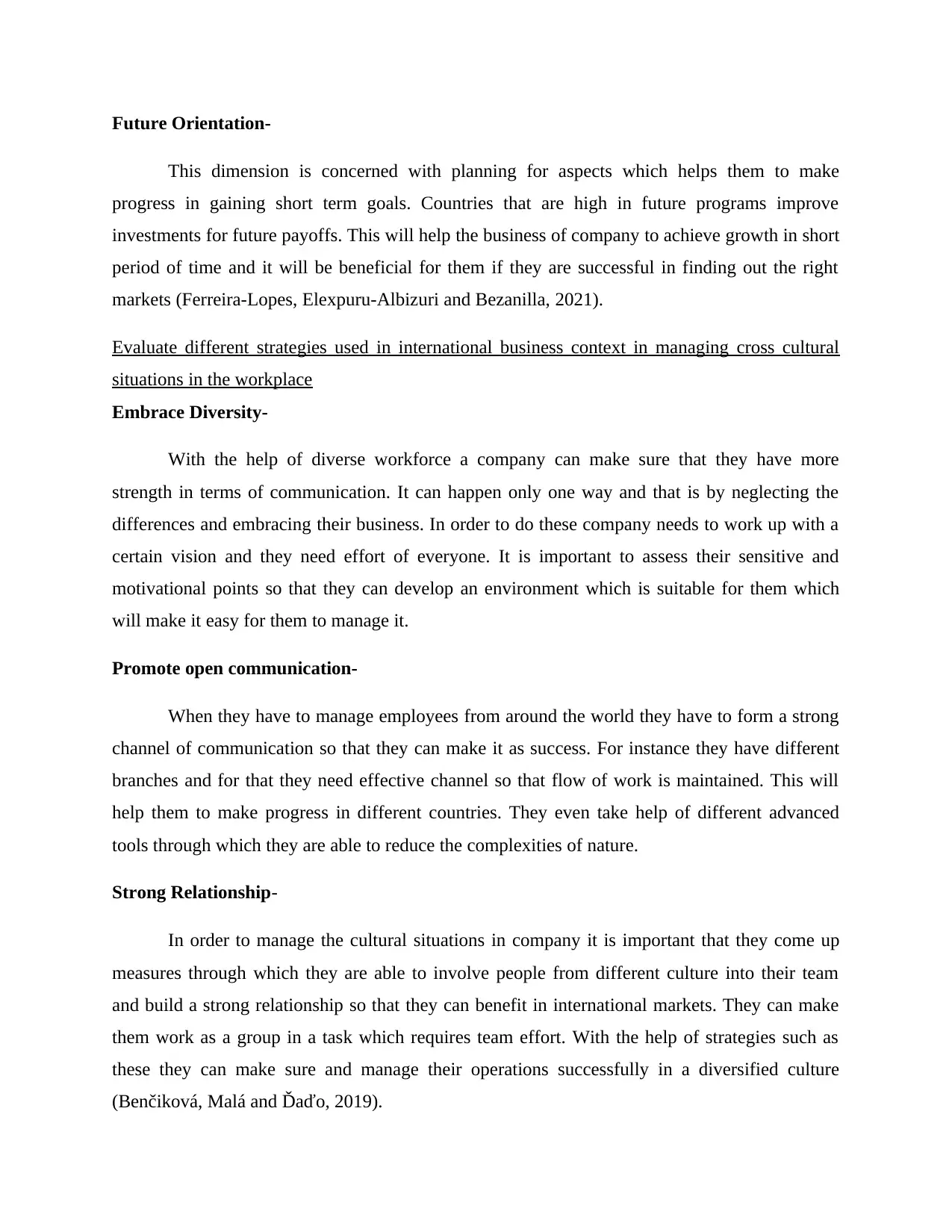
Future Orientation-
This dimension is concerned with planning for aspects which helps them to make
progress in gaining short term goals. Countries that are high in future programs improve
investments for future payoffs. This will help the business of company to achieve growth in short
period of time and it will be beneficial for them if they are successful in finding out the right
markets (Ferreira-Lopes, Elexpuru-Albizuri and Bezanilla, 2021).
Evaluate different strategies used in international business context in managing cross cultural
situations in the workplace
Embrace Diversity-
With the help of diverse workforce a company can make sure that they have more
strength in terms of communication. It can happen only one way and that is by neglecting the
differences and embracing their business. In order to do these company needs to work up with a
certain vision and they need effort of everyone. It is important to assess their sensitive and
motivational points so that they can develop an environment which is suitable for them which
will make it easy for them to manage it.
Promote open communication-
When they have to manage employees from around the world they have to form a strong
channel of communication so that they can make it as success. For instance they have different
branches and for that they need effective channel so that flow of work is maintained. This will
help them to make progress in different countries. They even take help of different advanced
tools through which they are able to reduce the complexities of nature.
Strong Relationship-
In order to manage the cultural situations in company it is important that they come up
measures through which they are able to involve people from different culture into their team
and build a strong relationship so that they can benefit in international markets. They can make
them work as a group in a task which requires team effort. With the help of strategies such as
these they can make sure and manage their operations successfully in a diversified culture
(Benčiková, Malá and Ďaďo, 2019).
This dimension is concerned with planning for aspects which helps them to make
progress in gaining short term goals. Countries that are high in future programs improve
investments for future payoffs. This will help the business of company to achieve growth in short
period of time and it will be beneficial for them if they are successful in finding out the right
markets (Ferreira-Lopes, Elexpuru-Albizuri and Bezanilla, 2021).
Evaluate different strategies used in international business context in managing cross cultural
situations in the workplace
Embrace Diversity-
With the help of diverse workforce a company can make sure that they have more
strength in terms of communication. It can happen only one way and that is by neglecting the
differences and embracing their business. In order to do these company needs to work up with a
certain vision and they need effort of everyone. It is important to assess their sensitive and
motivational points so that they can develop an environment which is suitable for them which
will make it easy for them to manage it.
Promote open communication-
When they have to manage employees from around the world they have to form a strong
channel of communication so that they can make it as success. For instance they have different
branches and for that they need effective channel so that flow of work is maintained. This will
help them to make progress in different countries. They even take help of different advanced
tools through which they are able to reduce the complexities of nature.
Strong Relationship-
In order to manage the cultural situations in company it is important that they come up
measures through which they are able to involve people from different culture into their team
and build a strong relationship so that they can benefit in international markets. They can make
them work as a group in a task which requires team effort. With the help of strategies such as
these they can make sure and manage their operations successfully in a diversified culture
(Benčiková, Malá and Ďaďo, 2019).
⊘ This is a preview!⊘
Do you want full access?
Subscribe today to unlock all pages.

Trusted by 1+ million students worldwide
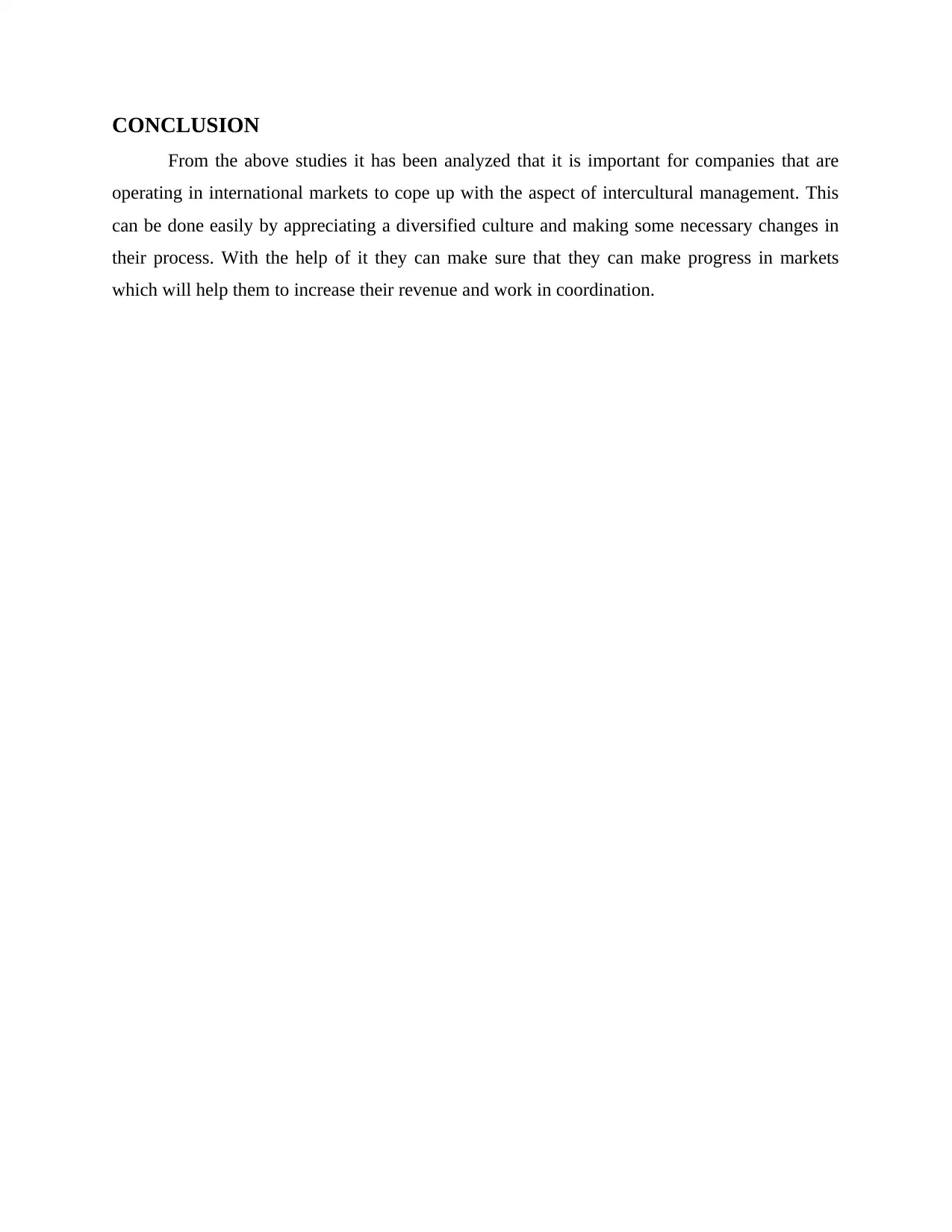
CONCLUSION
From the above studies it has been analyzed that it is important for companies that are
operating in international markets to cope up with the aspect of intercultural management. This
can be done easily by appreciating a diversified culture and making some necessary changes in
their process. With the help of it they can make sure that they can make progress in markets
which will help them to increase their revenue and work in coordination.
From the above studies it has been analyzed that it is important for companies that are
operating in international markets to cope up with the aspect of intercultural management. This
can be done easily by appreciating a diversified culture and making some necessary changes in
their process. With the help of it they can make sure that they can make progress in markets
which will help them to increase their revenue and work in coordination.
Paraphrase This Document
Need a fresh take? Get an instant paraphrase of this document with our AI Paraphraser
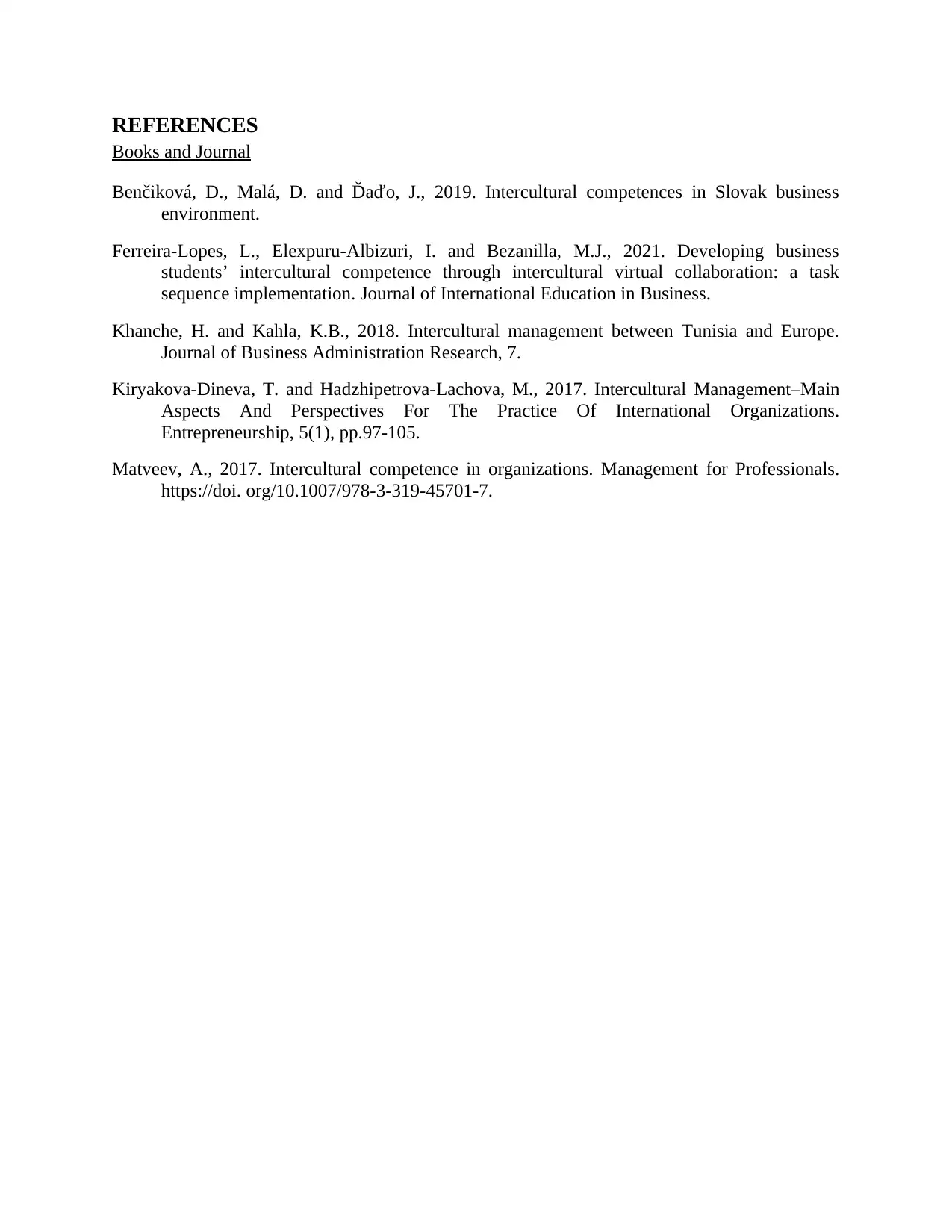
REFERENCES
Books and Journal
Benčiková, D., Malá, D. and Ďaďo, J., 2019. Intercultural competences in Slovak business
environment.
Ferreira-Lopes, L., Elexpuru-Albizuri, I. and Bezanilla, M.J., 2021. Developing business
students’ intercultural competence through intercultural virtual collaboration: a task
sequence implementation. Journal of International Education in Business.
Khanche, H. and Kahla, K.B., 2018. Intercultural management between Tunisia and Europe.
Journal of Business Administration Research, 7.
Kiryakova-Dineva, T. and Hadzhipetrova-Lachova, M., 2017. Intercultural Management–Main
Aspects And Perspectives For The Practice Of International Organizations.
Entrepreneurship, 5(1), pp.97-105.
Matveev, A., 2017. Intercultural competence in organizations. Management for Professionals.
https://doi. org/10.1007/978-3-319-45701-7.
Books and Journal
Benčiková, D., Malá, D. and Ďaďo, J., 2019. Intercultural competences in Slovak business
environment.
Ferreira-Lopes, L., Elexpuru-Albizuri, I. and Bezanilla, M.J., 2021. Developing business
students’ intercultural competence through intercultural virtual collaboration: a task
sequence implementation. Journal of International Education in Business.
Khanche, H. and Kahla, K.B., 2018. Intercultural management between Tunisia and Europe.
Journal of Business Administration Research, 7.
Kiryakova-Dineva, T. and Hadzhipetrova-Lachova, M., 2017. Intercultural Management–Main
Aspects And Perspectives For The Practice Of International Organizations.
Entrepreneurship, 5(1), pp.97-105.
Matveev, A., 2017. Intercultural competence in organizations. Management for Professionals.
https://doi. org/10.1007/978-3-319-45701-7.
1 out of 8
Related Documents
Your All-in-One AI-Powered Toolkit for Academic Success.
+13062052269
info@desklib.com
Available 24*7 on WhatsApp / Email
![[object Object]](/_next/static/media/star-bottom.7253800d.svg)
Unlock your academic potential
Copyright © 2020–2025 A2Z Services. All Rights Reserved. Developed and managed by ZUCOL.




